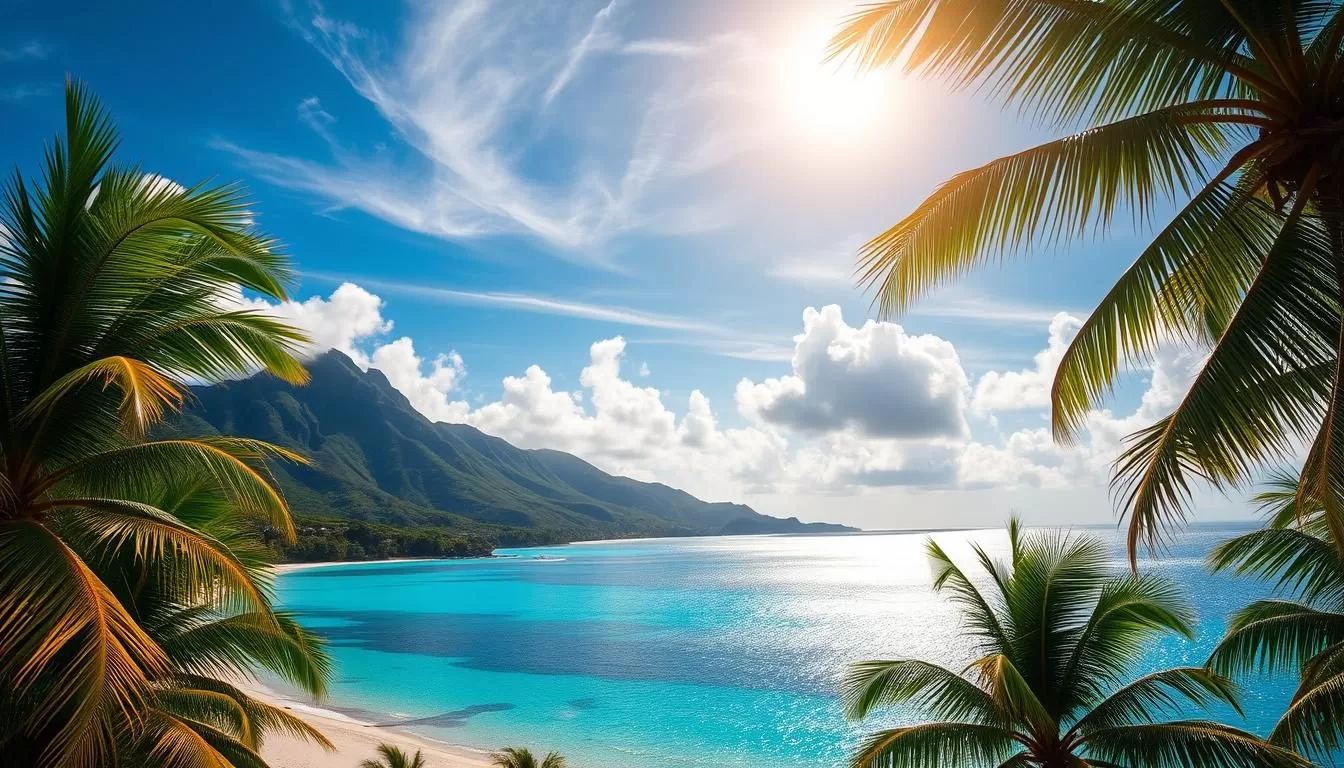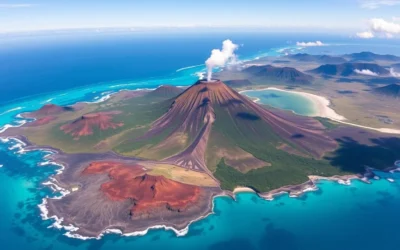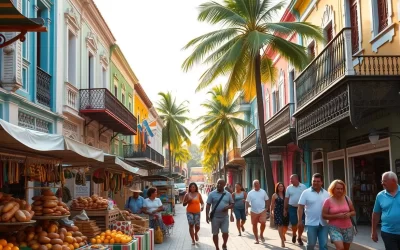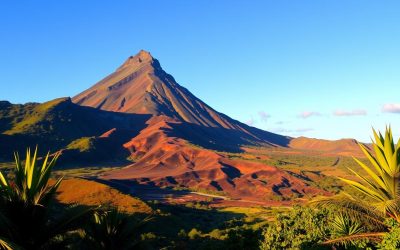✓ Accommodations✓ Flights✓ Rental Cars✓ Tours & Activities
Planning a trip to Reunion Island can be a thrilling experience, but understanding its unique climate is crucial for making the most of your visit. The island’s tropical climate means that the weather patterns can significantly impact your travel plans.
You’ll want to know when to expect sunshine, comfortable temperatures, and minimal rainfall to enjoy activities like hiking or relaxing on the beach. Reunion’s climate is characterized by distinct wet and dry seasons, which in turn affect the overall travel experience.
As you prepare for your trip, understanding the best time to visit based on your interests and preferences is essential. Whether you’re looking to explore volcanic landscapes, enjoy beach activities, or immerse yourself in the local culture, timing your visit right can make all the difference.
Understanding Reunion Island’s Climate
Reunion Island’s climate is a fascinating blend of tropical and maritime influences. This unique combination creates a diverse range of weather conditions across the island.

Tropical Maritime Climate
Reunion Island experiences a tropical maritime climate, characterized by warm temperatures throughout the year. However, there are significant seasonal variations in rainfall and humidity. The island’s position in the Indian Ocean exposes it to trade winds, which significantly influence weather patterns.
Distinct Wet and Dry Seasons
The island has distinct wet and dry seasons, creating different landscapes and experiences depending on when you visit. During the wet months, the vegetation is lush and vibrant, while the dry season offers clearer skies and better visibility. Understanding these seasonal changes is crucial for planning your activities.
Microclimate Variations Across the Island
Reunion’s mountainous topography leads to dramatic microclimate variations. The east coast typically receives more rainfall than the drier western regions. In the central highlands, temperatures are cooler compared to coastal areas, decreasing by approximately 0.7°C for every 100 meters of elevation gain. This variation allows for flexible itineraries, as you can experience sunshine on one side of the island while it’s raining on the other.
By understanding Reunion Island’s climate and its variations, you can better plan your trip and make the most of your visit, regardless of the month you choose to travel.
The Dry Season: May to October
Reunion Island’s dry season, which lasts from May to October, offers a unique blend of pleasant weather and exciting outdoor activities. This period is characterized by lower humidity, reduced rainfall, and pleasantly warm temperatures ranging from 22°C to 28°C (72°F to 82°F) along the coast.
Weather Patterns and Temperature Ranges
During the dry season, the clear skies and dry conditions create ideal circumstances for outdoor enthusiasts. You’ll experience cooler temperatures in the highlands, making it a great time to tackle challenging trails like the hike to Piton de la Fournaise, one of the world’s most active volcanoes.
Ideal Outdoor Activities
This is widely considered the best time to visit Reunion for outdoor enthusiasts, as the weather conditions are perfect for hiking, paragliding, and exploring the island’s three cirques. The dry season also offers the most reliable weather for water activities like snorkeling, diving, and whale watching, with the latter being particularly good between July and September when humpback whales migrate through Reunion’s waters.
Tourist Density and Pricing
Tourist numbers gradually increase throughout the dry season, peaking in July and August during European summer holidays, which impacts both accommodation availability and prices. While prices tend to be higher during this peak season, the predictable weather makes it worth the premium for travelers focused on outdoor adventures and activities that are weather-dependent.
The drier conditions also mean less lush vegetation in some areas, but the trade-off is better visibility for spectacular panoramic views from the island’s many viewpoints. Overall, the dry season is an excellent time to visit Reunion Island, offering a great balance of pleasant weather and exciting activities for tourist alike.
The Wet Season: November to April
Visiting Reunion Island during its wet season, from November to April, offers a distinct experience with lush landscapes and fewer tourists. This period is characterized by higher humidity, increased rainfall, and warmer temperatures averaging between 25°C and 30°C (77°F to 86°F) in coastal areas.
Rainfall Patterns and Humidity Levels
During the wet season, you can expect brief but intense rain showers, typically in the afternoons, while mornings often remain sunny and clear. The increased rainfall significantly contributes to the island’s lush vegetation, making it a great time for nature lovers and photographers.
Cyclone Season Considerations
The wet season coincides with the cyclone season in the Indian Ocean, with the greatest risk occurring between January and March. It’s crucial to monitor weather forecasts closely during this time to ensure your safety.
Lush Landscapes and Waterfalls
Despite the rain, this can be a magical time to visit Reunion as the increased rainfall transforms the landscape, with vegetation at its most lush and waterfalls at their most spectacular. The eastern and northeastern parts of the island receive significantly more rainfall than the western coast, which remains relatively drier even during the wet season.
The wet season offers several benefits, including lower accommodation prices and fewer tourists, making it an attractive option for budget-conscious travelers who don’t mind working around occasional rain showers. This period is also ideal for photographers looking to capture Reunion’s dramatic landscapes enhanced by atmospheric clouds, vibrant greenery, and powerful waterfalls in full flow.
Peak Tourist Season: July to August
The peak tourist season in Reunion Island occurs in July and August, bringing vibrant energy to the island. This period coincides with European summer holidays and French school breaks, making it the busiest time of the year.
School Holiday Impact
During July and August, Reunion Island is flooded with families on vacation, significantly impacting the island’s tourism infrastructure. The influx of visitors results in a lively atmosphere, with many cultural events and activities being organized.
Accommodation Availability and Prices
You can expect the highest accommodation prices during this peak season, with hotels and vacation rentals booking up quickly. It’s essential to book your accommodations at least 3-6 months in advance to secure availability and potentially better rates.
Popular Attractions and Crowds
Popular attractions like Piton de la Fournaise, the beaches of L’Hermitage, and the mountain villages experience their heaviest crowds. Despite the crowds, the weather is usually sunny and dry, making it ideal for outdoor activities.
The increased number of visitors also means more frequent public transportation options and extended hours at many attractions and restaurants. While popular spots can get crowded, the island is large enough to allow you to find quieter spots by venturing off the beaten path.
To make the most of your visit during the peak tourist season, plan ahead, and consider exploring less crowded areas. With proper planning, you can enjoy the best that Reunion Island has to offer.
Shoulder Seasons: April-May and September-November
For travelers looking for the best of Reunion Island without the peak season crowds, the shoulder seasons are definitely worth considering. The periods of April-May and September-November offer a perfect blend of favorable weather and fewer tourists.
Weather Advantages
During April-May, you experience a transition from the wet to the dry season, with rainfall and humidity gradually decreasing. The landscapes remain lush from the recent rainy season, providing a beautiful backdrop for your travels. In contrast, September-November marks the transition from dry to wet season, with increasing rainfall but still plenty of sunny days. The landscapes begin to green up again after the drier months, offering a unique visual appeal.
Fewer Tourists and Better Deals
One of the significant advantages of visiting during the shoulder season is the reduction in tourist numbers, making popular destinations less crowded. Additionally, you can benefit from significantly lower accommodation prices, with many hotels offering discounts of 20-30% compared to peak season rates. This period is particularly great for hiking and outdoor activities as the trails are less crowded and the weather remains generally favorable.
Unique Seasonal Experiences
The shoulder seasons also coincide with some of Reunion’s interesting cultural events, such as the Grand Raid ultra-marathon in October and various harvest festivals. Moreover, the water temperatures remain pleasant, ranging from 24°C to 26°C (75°F to 79°F), making it excellent for swimming, snorkeling, and other water activities. Whether you’re looking for adventure, cultural experiences, or simply relaxation, the shoulder seasons offer a great balance.
Reunion: Best Months for a Weather-Savvy Trip by Activity
The best time to visit Reunion Island depends on the activities you have planned, with different months offering ideal conditions for various pursuits. Whether you’re looking to hike, enjoy beach activities, or explore the island’s wildlife, understanding the optimal time for your preferred activities is key to a successful trip.
Hiking and Volcano Exploration
For hiking enthusiasts, the best months are May through November when trails are drier and less slippery. June to September offers the clearest views for those challenging summit hikes to Piton des Neiges or Piton de la Fournaise. During this period, the weather conditions are optimal for exploring Reunion’s volcanic landscapes.
Beach Activities and Water Sports
If beach activities and water sports are your priority, you’ll find the most consistent conditions from April to November. Water temperatures range around 24-26°C (75-79°F), and the seas are calmer, particularly on the protected western coast. This period is ideal for swimming, surfing, and other water activities.
Wildlife and Nature Photography
Wildlife photographers should consider visiting between July and September for whale watching opportunities. Bird watchers will find year-round opportunities, with slightly better conditions during the drier months. For lush landscape photography with dramatic waterfalls, plan your trip during the latter part of the wet season (March-April) when rainfall begins to decrease but the landscape remains vibrantly green.
Adventure sports like paragliding and canyoning are best enjoyed during the dry season (May-October) when water levels in ravines are lower and thermal conditions for paragliding are more predictable. If you’re interested in exploring Reunion’s underwater world, visibility is typically best during the dry season, particularly from September to November when water clarity can reach up to 30 meters.
Cultural immersion activities and market visits can be enjoyed year-round, though the shoulder seasons offer the advantage of fewer tourists at cultural sites and more authentic local experiences.
Cultural Festivals and Events Calendar
Experience the vibrant cultural scene of Reunion Island through its diverse festivals and events throughout the year. The island’s cultural calendar is packed with a variety of celebrations that reflect its rich heritage, blending African, Indian, Chinese, and European influences.
Traditional Celebrations
January marks the beginning of the year with Chinese New Year celebrations, particularly in Saint-Denis, where you can witness colorful parades, enjoy traditional music, and savor authentic Chinese cuisine. In March or April, the Tamil Hindu festival of Cavadee takes place, featuring fire walking and body piercing as acts of devotion, most prominently in Saint-André.
Music and Arts Festivals
June is a great time for music lovers as it hosts the Sakifo Music Festival, Reunion’s largest music event, bringing together local, regional, and international artists for three days of performances across multiple genres. The Grand Raid in September, also known as “La Diagonale des Fous,” is an ultra-marathon that attracts participants worldwide.
Religious and Cultural Events
The year concludes with significant cultural events, including Dipavali (Diwali) in October or November, celebrated with illuminations, music, and dance performances, particularly in areas with large Tamil communities. December features Fête Kaf on the 20th, commemorating the abolition of slavery in Reunion, with Maloya music performances, traditional food, and historical reenactments.
Reunion Island’s diverse cultural events and festivals make it a great time to visit, offering a unique glimpse into the island’s heritage and traditions. Whether you’re interested in music, cultural celebrations, or traditional practices, there’s always something happening on the island.
Month-by-Month Weather Guide
To make the most of your trip to Reunion Island, it’s vital to understand the island’s monthly weather patterns. Reunion Island’s climate varies significantly throughout the year, with distinct wet and dry seasons.
January to March: Heart of the Wet Season
January to March represents the heart of the wet season, with the highest rainfall and humidity levels. Average coastal temperatures range from 26-30°C (79-86°F), while highland areas are cooler at 17-22°C (63-72°F). You can expect brief but intense rain showers, typically in the afternoons, with mornings often remaining clear and sunny.
April to June: Transition to Dry Season
April to June marks the transition to the dry season, with gradually decreasing rainfall and humidity. Temperatures begin to cool slightly, ranging from 24-28°C (75-82°F) along the coast. By May, rain showers become less frequent and shorter in duration, making this an increasingly good time to visit for outdoor activities.
July to September: Peak Dry Season
July to September represents the peak dry season and winter in the southern hemisphere, with the coolest temperatures of the year ranging from 22-26°C (72-79°F) on the coast and as low as 10°C (50°F) in the highlands. These months offer the most reliable weather for outdoor activities, with clear skies, low humidity, and minimal rainfall.
October to December: Transition to Wet Season
October to December sees the gradual return of the rainy season, with increasing humidity and more frequent afternoon showers, particularly from late November onward. December marks the official start of summer in the southern hemisphere, with temperatures rising to 25-30°C (77-86°F) along the coast and increased rainfall.
Conclusion: Planning Your Weather-Perfect Trip to Reunion
The best time to visit Reunion depends on your priorities, whether you’re looking for optimal weather, fewer crowds, or budget-friendly options. For the most reliable weather and widest range of outdoor activities, plan your trip during the dry season from May to October.
However, be prepared for higher prices and more crowds, especially in July and August. If you’re looking to maximize value while still enjoying good weather, target the shoulder seasons of April-May or September-November when you’ll benefit from fewer crowds, better deals, and generally pleasant conditions.
Budget-conscious travelers might consider the wet season from November to April when accommodation prices drop significantly. No matter when you visit, pack layers for Reunion’s microclimates, as you can experience significant temperature variations in a single day. Consider the island’s regional weather patterns when planning your itinerary.
For specialized activities like whale watching or attending specific cultural festivals, you may need to plan your trip around these fixed seasonal events. Reunion’s diverse landscapes, rich cultural heritage, and warm hospitality ensure a memorable experience throughout the year. Whichever month you choose to visit this tropical paradise, you’re sure to have a great trip.
The above is subject to change.
Check back often to TRAVEL.COM for the latest travel tips and deals.





